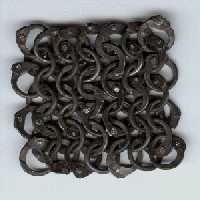Traveling within the World
Linking your favorite traveling artists across the globe
Riveted Maille, A practical approach. by Rev. George
Riveted maille has long been an elusive art, oft spoken of with much more difficult that it really is. In this essay, It is my intention to shed some light on a simple, effective method of producing riveted maille. Before I go any further, I would like to thank the following people: Stephen of Forth Castle, his study into techniques, as well as oft questions define the impetus for my interest; Eric Schmidt, he also shed some light ; both of these gentlemen frequent the Armour Archive Sara Trice, also a good source for information, as her Sara's chain mail connection is a temple of maille. After this, the metal is much more soft, and can be easily hammered, bent, etc. Eventually the rings will need to be overlapped, and flattened, but i find it easier to do a "pre flatten", a step which some people consider unneeded. I personally feel it adds a small step, but makes a second step easier. To pre flatten, merely place on a flat, heavy metal surface (anvil, metal weight, railroad track, etc.) and strike the ends with a hammer until slightly flattened, thusly:
**It has come to my attention that the proprietor of Strangeblades has removed said helpful and informative essay. it seems that she had several complaints ranging from the legitimate ("you've stolen my images", or "You've plagiarized my jewelry designs") to the absurd ("how dare you link my page!"). Sigh. Its a shame that its gone, but I shall leave the link up, so that you can read her side of the story. |
Tags:
Replies to This Discussion
Events
-
2014 is the Chinese Year of the Horse
February 17, 2026 at 12am to February 5, 2027 at 12am – where & how you choose
Birthdays
Birthdays Today
Birthdays Tomorrow
Important (read & understand)
Skype: Travelingraggyman
Email and Instant Messenger:
TravelerinBDFSM @ aol/aim; hotmail; identi.ca; live & yahoo
OR
Travelingraggyman @ gmail and icq ***

1AWARD UPDATES & INFORMATION
10,000 votes - Platinum Award
5,000 votes - Gold Award
2,500 votes - Silver Award
1,000 votes - Bronze Award
300 votes - Pewter Award
100 votes - Copper Award
Member of the Associated Posting System {APS}
This allows members on various sites to share information between sites and by providing a by line with the original source it credits the author with the creation.
Legal Disclaimer
***************We here at Traveling within the World are not responsible for anything posted by individual members. While the actions of one member do not reflect the intentions of the entire social network or the Network Creator, we do ask that you use good judgment when posting. If something is considered to be inappropriate it will be removed
Site Meter
This site is strictly an artist operational fan publication, no copyright infringement intended
Patchwork Merchant Mercenaries had its humble beginnings as an idea of a few artisans and craftsmen who enjoy performing with live steel fighting. As well as a patchwork quilt tent canvas. Most had prior military experience hence the name.
Patchwork Merchant Mercenaries.
Vendertainers that brought many things to a show and are know for helping out where ever they can.
As well as being a place where the older hand made items could be found made by them and enjoyed by all.
We expanded over the years to become well known at what we do. Now we represent over 100 artisans and craftsman that are well known in their venues and some just starting out. Some of their works have been premiered in TV, stage and movies on a regular basis.
Specializing in Medieval, Goth , Stage Film, BDFSM and Practitioner.
Patchwork Merchant Mercenaries a Dept of, Ask For IT was started by artists and former military veterans, and sword fighters, representing over 100 artisans, one who made his living traveling from fair to festival vending medieval wares. The majority of his customers are re-enactors, SCAdians and the like, looking to build their kit with period clothing, feast gear, adornments, etc.
Likewise, it is typical for these history-lovers to peruse the tent (aka mobile store front) and, upon finding something that pleases the eye, ask "Is this period?"
A deceitful query!! This is not a yes or no question. One must have a damn good understanding of European history (at least) from the fall of Rome to the mid-1600's to properly answer. Taking into account, also, the culture in which the querent is dressed is vitally important. You see, though it may be well within medieval period, it would be strange to see a Viking wearing a Caftan...or is it?
After a festival's time of answering weighty questions such as these, I'd sleep like a log! Only a mad man could possibly remember the place and time for each piece of kitchen ware, weaponry, cloth, and chain within a span of 1,000 years!! Surely there must be an easier way, a place where he could post all this knowledge...
Traveling Within The World is meant to be such a place. A place for all of these artists to keep in touch and directly interact with their fellow geeks and re-enactment hobbyists, their clientele.
© 2025 Created by Rev. Allen M. Drago ~ Traveler.
Powered by
![]()
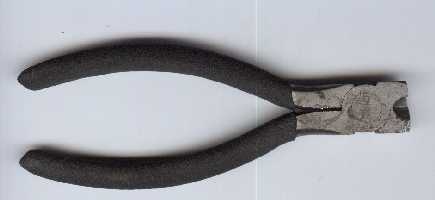
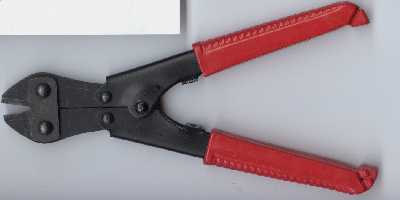
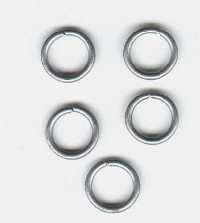
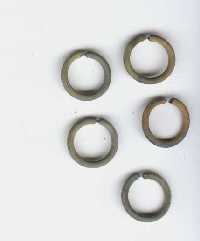
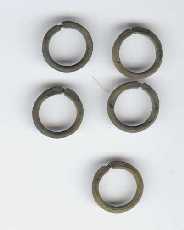
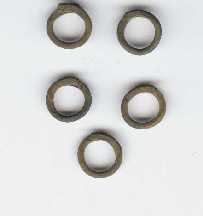
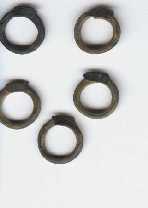
 You can pick them up at Wal-Mart, for around 2 bucks. Anneal them, I do this by pouring them into a metal ladle, and heating them with a torch, then allowing to slowly cool. Put them through the hole you made, trim the length, and squeeze them between pliers. This will set your rivet. Assemble in the usual way. If you have never made Maille before, I shall refer you to the
You can pick them up at Wal-Mart, for around 2 bucks. Anneal them, I do this by pouring them into a metal ladle, and heating them with a torch, then allowing to slowly cool. Put them through the hole you made, trim the length, and squeeze them between pliers. This will set your rivet. Assemble in the usual way. If you have never made Maille before, I shall refer you to the 